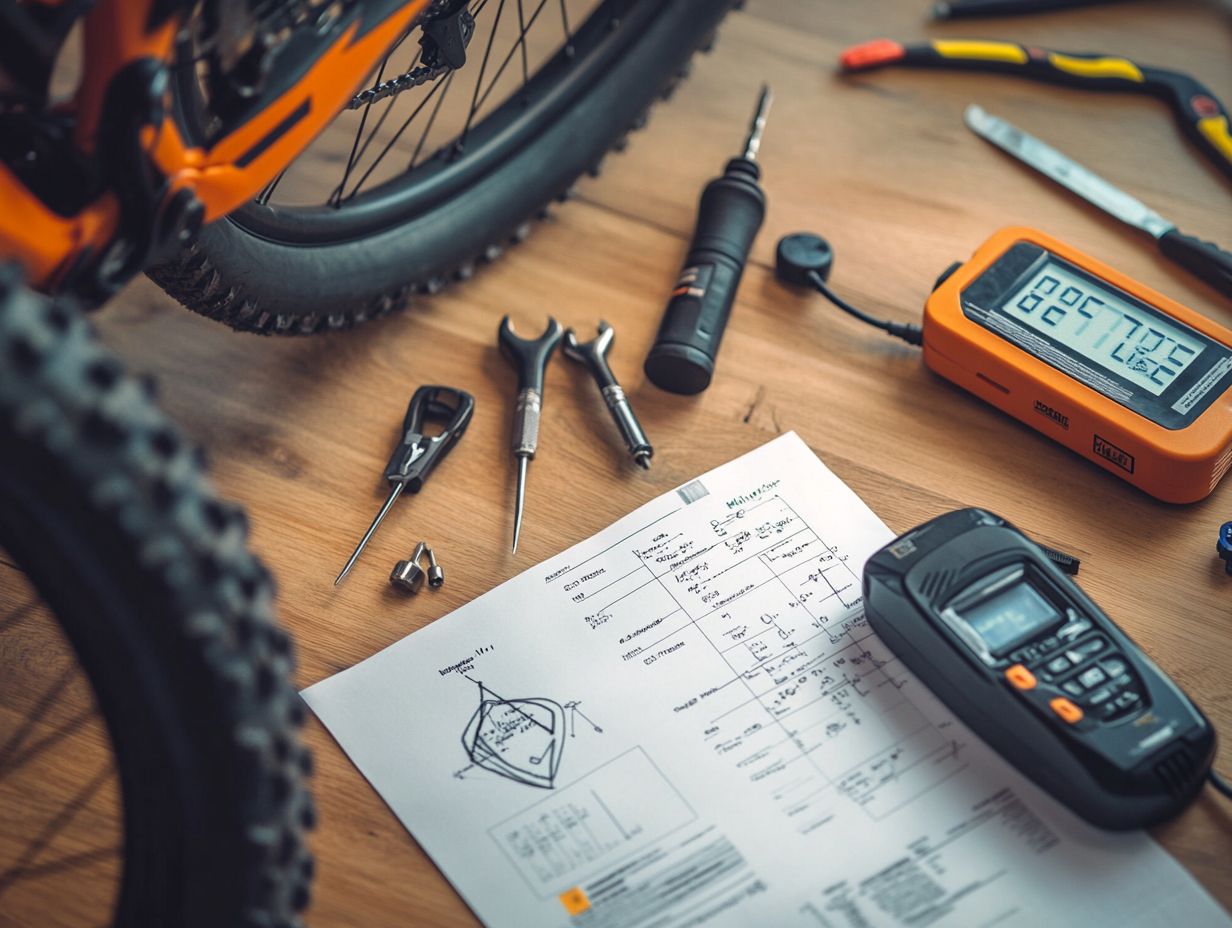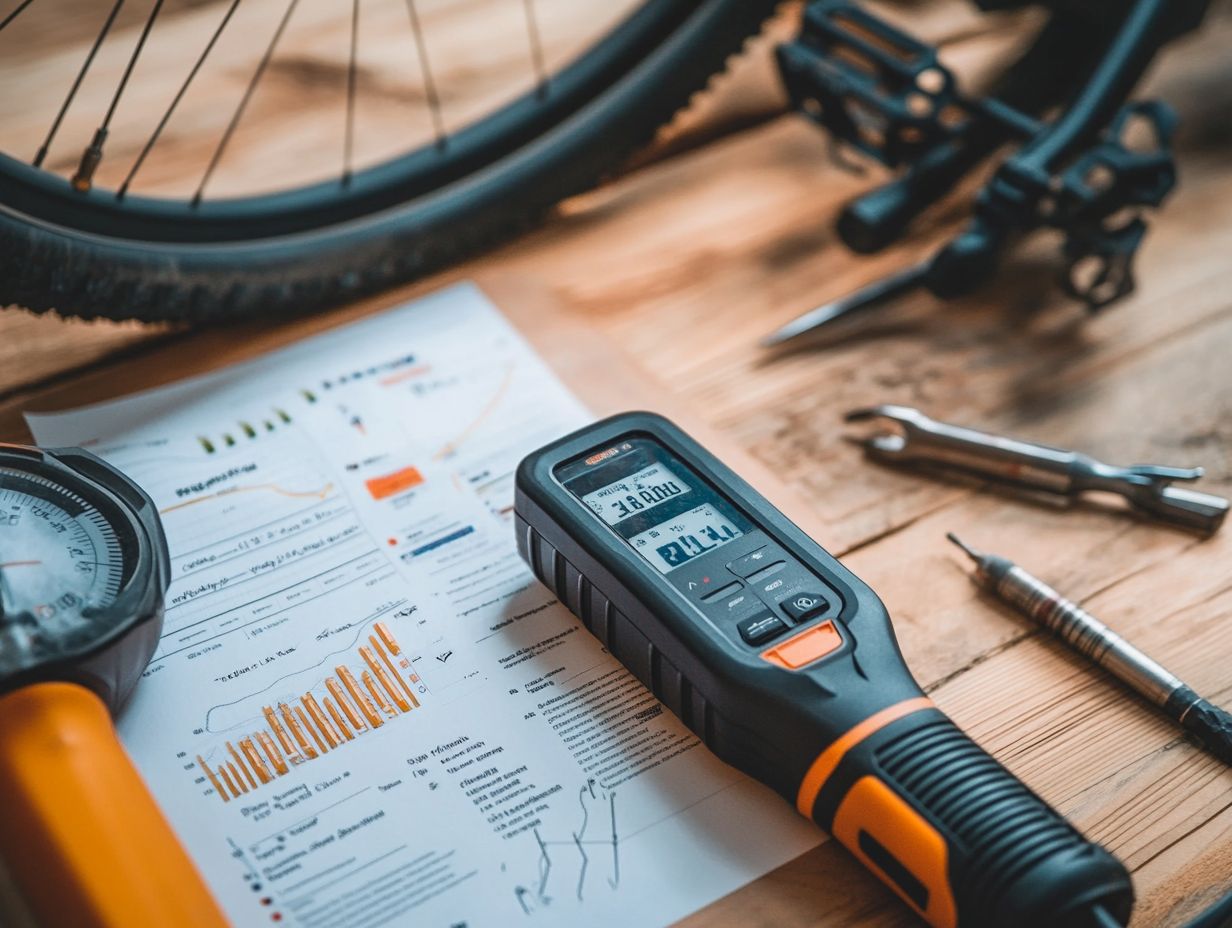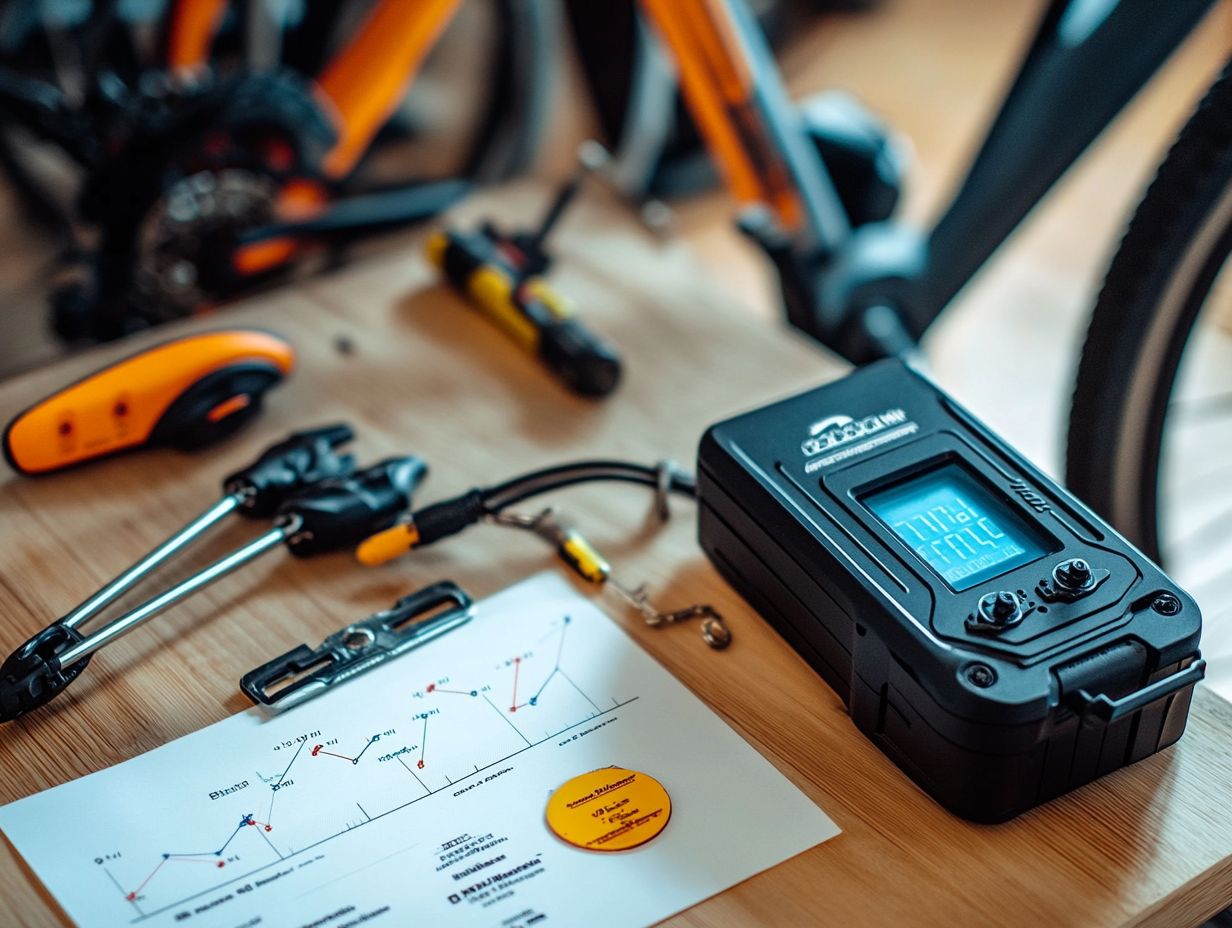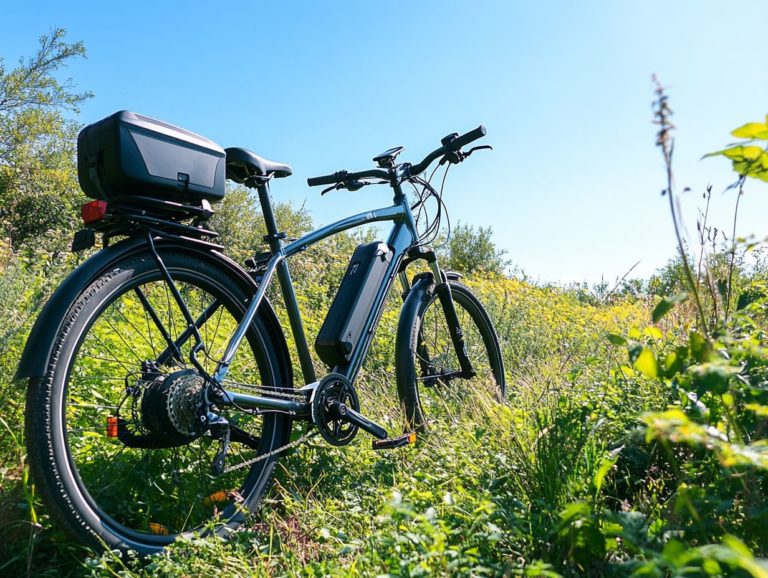Understanding E-Bike Battery Lifespan
E-bike batteries are the heart and soul of electric bikes, energizing your rides and shaping your overall experience. With the latest advancements in lithium technology, they ensure efficient power delivery.
Get ready to uncover the secrets of e-bike batteries that can transform your riding experience! In this article, you ll discover essential components and the various factors that influence an e-bike battery’s lifespan think usage habits, environmental factors, and the role of quality in overall performance.
You ll also find practical maintenance tips to help you extend your battery’s life. Learn when it might be time for a replacement, including costs and options from reputable brands like Samsung, Panasonic, and LG.
Whether you re a seasoned e-bike enthusiast or just starting out, understanding the importance of battery management and monitoring will elevate your riding journey to new heights.
Contents
Key Takeaways:

- E-bike batteries are an essential component of electric bikes, providing power for longer rides and faster speeds, especially during electric mountain bike excursions.
- The lifespan of an e-bike battery is affected by usage habits, environmental conditions, and the quality of the battery itself, including its capacity and energy density.
- To extend the lifespan of your e-bike battery, regular maintenance, waterproof care, and proper charging techniques are crucial. Replacements should be considered when the battery no longer holds a charge or shows signs of degradation.
What is an E-Bike Battery?
An e-bike battery is essential for electric bikes, supplying the power and energy needed to propel you forward and elevate your riding experience. Crafted from cutting-edge lithium-ion technology, these batteries are lightweight yet remarkably durable, allowing you to travel longer distances while maintaining efficiency.
The capacity, voltage, and energy density of the battery significantly influence how enjoyable your ride will be, impacting both the range and overall performance. With options from renowned manufacturers like Samsung, Panasonic, and LG, you can choose from various models that feature unique components. This ensures you find the perfect battery tailored to your specific needs and riding conditions.
Overview and Components
The components of an e-bike battery are essential for maximizing both efficiency and safety. They comprise cells, a Battery Management System (BMS), and a protective casing.
The cells act as the heart of the battery, where chemical reactions unleash energy to power various functionalities. Their design and quality are key factors that influence overall performance. They determine not only the consistency of energy output but also how far you can travel on a single charge.
The BMS is a system that keeps the battery safe and efficient, meticulously overseeing charging cycles to ensure each cell remains balanced and protected against the perils of overcharging or deep discharging. This vigilant management not only extends the battery s lifespan by preventing degradation, but it also enhances safety by monitoring temperature and voltage levels.
Finally, the protective casing wraps everything in a reliable shield against environmental factors, ensuring the battery’s durability. This all contributes to an uninterrupted and enjoyable riding experience, allowing you to focus on the journey ahead.
Factors Affecting E-Bike Battery Lifespan
The lifespan of an e-bike battery hinges on various factors, such as your usage habits, environmental conditions, and the overall quality of the battery itself. Each of these elements can profoundly impact its longevity and performance.
Frequent charging cycles and improper storage can lead to significant degradation. Exposure to extreme weather can jeopardize the battery’s integrity. Understanding these factors is crucial if you want to maximize your battery’s lifespan and efficiency.
Start taking care of your battery today to avoid costly replacements tomorrow!
Ready to enhance your e-bike experience? Dive into our maintenance tips now!
Usage Habits
Your usage habits directly affect your E-Bike battery s performance and lifespan. Things like energy consumption and charging cycles are influenced by how you ride.
While frequent short commutes may seem easier on the battery compared to long, demanding mountain biking adventures, both can impact overall battery health. It s essential to recognize that consistently draining the battery to very low levels can shorten its lifespan and lead to performance issues.
Aim to maintain a moderate charge level between 20% and 80% for optimal performance.
Mixing up your riding routes and steering clear of steep inclines regularly can help reduce strain on the battery, promoting better energy efficiency. Stick to a consistent charging routine, like charging after every ride instead of waiting until the battery is nearly empty. For more detailed advice, check out how to optimize battery lifespan in electric bicycles. This can significantly enhance longevity, efficiency, and performance.
Environmental Factors

Weather conditions and temperature profoundly impact the performance and durability of your E-Bike batteries. If not properly managed, these elements can lead to wear and tear over time.
Take rain, for example. When your batteries are exposed to moisture, they can suffer from intrusion, leading to short circuits and a decreased lifespan. On the flip side, extreme heat can speed up chemical reactions within the battery, ultimately reducing its efficiency and capacity.
To navigate these challenges, it s essential to adopt protective measures. Use weather-resistant covers and store your batteries in temperature-controlled environments. Proper storage techniques, such as keeping your batteries in a cool, dry place when not in use, can significantly extend their lifespan and maintain optimal performance.
Quality of Battery
The quality of your E-Bike battery is crucial in determining its overall longevity and performance, especially when considering various brands. Choosing reputable manufacturers like Samsung, Panasonic, and LG means tapping into the pinnacle of lithium battery technology.
High-quality batteries from trusted brands significantly enhance not only the range of your E-Bike but also its charging cycles and lifespan, leading to a far superior riding experience.
As you compare the various battery technologies available lithium-ion, nickel-metal hydride, and lead-acid you’ll find that lithium-ion stands out for its exceptional how much energy it can store and efficiency.
Investing in a premium lithium battery allows you to enjoy longer rides without the hassle of frequent recharges. Therefore, it’s essential to consider the source of the battery and the manufacturer’s reputation before making your purchase. Additionally, understanding e-bike battery accessories can further enhance your riding experience.
How to Extend the Lifespan of Your E-Bike Battery
Want to make your E-Bike battery last longer? Here s how! You can significantly extend its lifespan by employing effective maintenance tips and optimal charging techniques. These practices will enhance both its overall performance and longevity, ensuring you enjoy seamless rides for years to come.
Maintenance Tips
Regular maintenance, including care for battery terminals and charging cycles, is essential for ensuring your E-Bike battery performs at its best and lasts a long time. Simple care practices, such as monitoring voltage levels, can make a big difference.
By routinely checking and cleaning the battery terminals, you can prevent corrosion and maintain a reliable connection. Keep an eye out for signs of wear, like frayed wires or swelling, as these issues can significantly affect efficiency and safety.
Ensuring that the battery has proper ventilation during charging boosts its performance and extends its lifespan. By staying vigilant and proactive about these maintenance tips, you empower yourself to enjoy a seamless riding experience while sidestepping costly replacements.
Start implementing these tips today for a longer-lasting, more efficient ride!
Proper Charging Techniques
Proper charging techniques can boost your E-Bike battery’s lifespan. They ensure efficient energy use throughout its lifecycle and enhance overall sustainability.
Implementing a few simple best practices can truly make a significant difference. For instance, avoid overcharging your battery, as this can lead to overheating and ultimately diminish its life, compromising safety. It’s wise to use the manufacturer-recommended chargers; they are designed to match your battery’s specifications.
Understanding the impact of different charging cycles is crucial for maintaining battery health and maximizing lifespan. Frequent short charges can create unnecessary strain, while deep discharges can be equally harmful. By following these practices and learning how to maintain your electric bicycle for longevity, you can enhance your battery’s health, promote optimal performance, and extend the longevity of your E-Bike’s power source, ensuring an enjoyable riding experience.
Replacing an E-Bike Battery

Replacing your E-Bike battery is a big choice that you should think about carefully. It s important to weigh factors like cost, options from different manufacturers, and your electric bike’s specific needs.
Each choice can significantly impact your riding experience and overall satisfaction.
When to Replace
It’s important to know when to replace your E-Bike battery to keep it performing well. Key indicators, such as a decreased range and noticeable wear and tear, serve as clear signals that it s time for a change.
As you use your E-Bike for commuting or leisure, you may start to notice signs of battery trouble. Reduced performance could present itself as sluggish acceleration or diminished pedal assist. Let’s not forget the frustration of increased charging times. To make informed decisions about replacements, regularly monitor your battery’s health and performance metrics. Knowing when to replace your electric bicycle battery can help ensure your E-Bike remains in top shape.
Keeping an eye on these indicators allows you to spot patterns that suggest a declining battery, ensuring you stay ahead of your E-Bike s efficiency and extend its overall lifespan.
Costs and Options
Know the costs and options for replacing your E-Bike battery to make the best choice. Prices can vary considerably depending on battery type, brand, and performance specifications.
This variability arises mainly from the different technologies involved. Lithium-ion batteries often come with a higher price tag, but they’re known for their exceptional longevity and efficiency compared to traditional lead-acid batteries. While lead-acid options may seem more budget-friendly at first, they frequently require replacements, leading to greater long-term costs.
When comparing choices from various manufacturers, look beyond just the initial price. Consider performance metrics like charge cycles and range, as well as warranty options that provide peace of mind. Additionally, using tips for maintaining your electric bicycle battery can enhance your E-Bike’s longevity. By carefully evaluating these factors, you can make informed decisions that strike the right balance between cost and overall performance for your E-Bike.
Frequently Asked Questions
What is the average lifespan of an e-bike battery?
The average lifespan of an e-bike battery is typically between 2-4 years, depending on usage and maintenance. However, with proper care, it can last up to 5-6 years.
What factors affect the lifespan of an e-bike battery?

The lifespan of an e-bike battery can be affected by various factors such as temperature, charging habits, and overall usage. Extreme temperatures, frequent overcharging, and heavy usage can all contribute to a shorter lifespan for your battery.
How can I extend the lifespan of my e-bike battery?
To extend the lifespan of your e-bike battery, store it at a moderate temperature, avoid overcharging frequently, and charge it after each use. It’s also recommended not to drain the battery completely before recharging it.
What is the best way to charge an e-bike battery?
The best way to charge an e-bike battery is to use the manufacturer’s charger. Follow the recommended charging time and process for the best results.
How do I know when it’s time to replace my e-bike battery?
It s time to replace your e-bike battery when it loses capacity and can t hold a charge like before. If you see physical damage or bloating, replace it immediately.
Can I recycle my old e-bike battery?
Yes, you can recycle most e-bike batteries! Proper disposal is crucial to protect our planet let’s make a difference together!
Contact your local e-bike retailer or recycling center for safe disposal methods.






